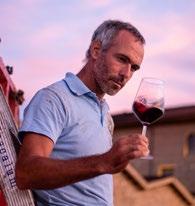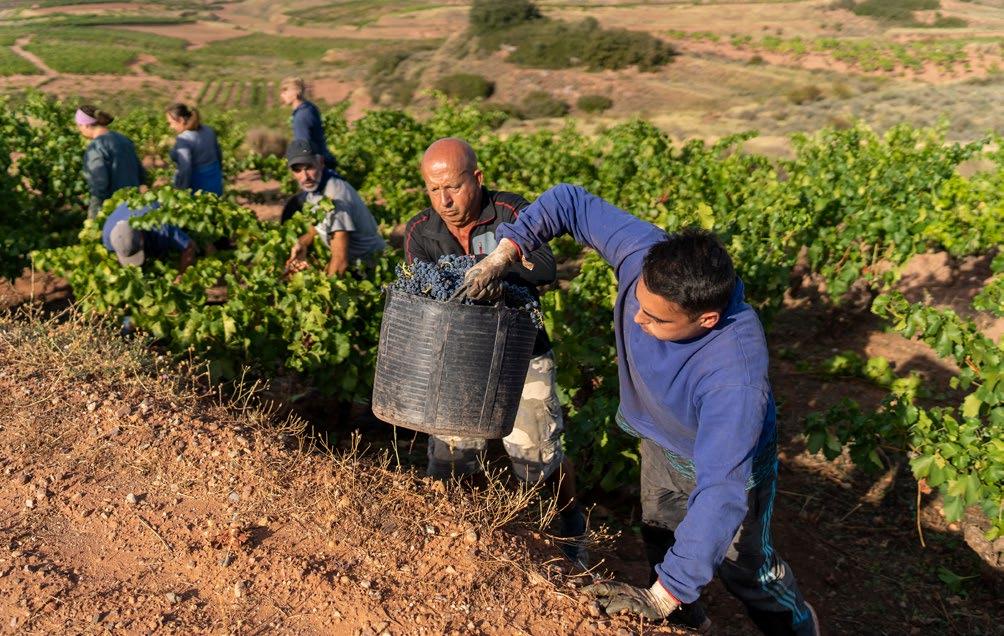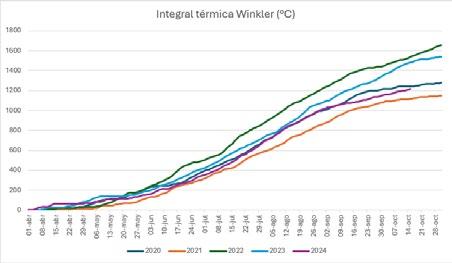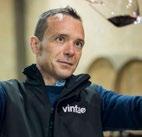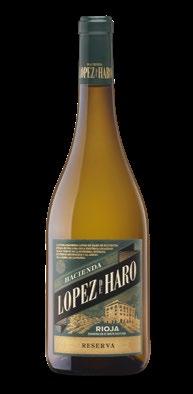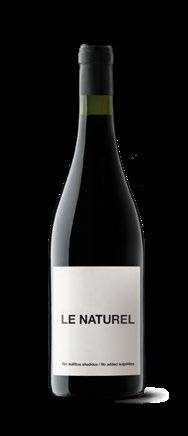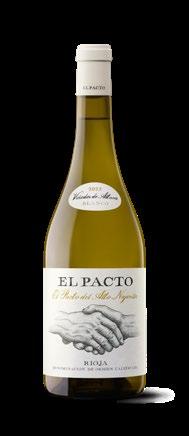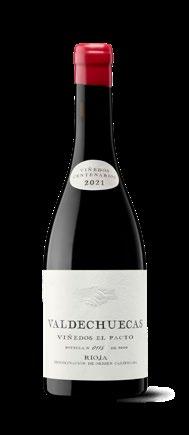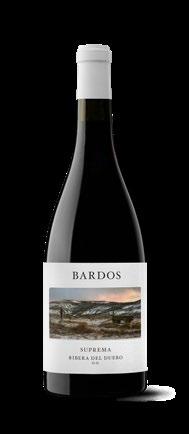Lessons from the 2024 Harvest
Richi Arambarri, founder and CEO of Vintae
In life, we often measure reality against the expectations we create. In farming, this tendency is even stronger. The entire year’s work hinges on the final stages of the vine’s development, where the weeks—or even days—leading up to the harvest are critical. The 2024 vintage is a perfect example of this.
Expectations were already high because it’s a year ending in 4, and some of the most iconic vintages carry this number: from the legendary 1964 to 1994 and 2004—even 2014 was an excellent year. Adding to this buzz was the fact that, over the past two decades, we’ve had a shortage of vintages rated as “excellent,” and it felt like we were “due for one.” With this background in mind, there was a lot of hope that 2024 would turn out to be an unforgettable harvest. "Indeed, the year got off to a promising start. In spring, the vineyards were in great shape, with almost no issues with disease. By late August, everything looked perfect: a small crop, but with exceptional quality—on track to becoming a standout vintage.
However, things became more complicated, and while
it may not be the ‘excellent’ harvest we had hoped for, as we watch the wines develop, I’m personally pleasantly surprised by many of them. It’s not just us—other prestigious wineries share this sentiment as well.
The 2024 vintage has reinforced a belief we’ve held for a long time: the importance of vineyard location in the right soils, where the vine can reach its full potential. Traditionally, vineyards have been planted on slopes with poor, well-drained soils, where dryfarmed vines produce balanced, high-quality grapes. However, in recent decades, some vineyards have shifted to less ideal land, soils historically used for other crops, where production is higher but quality is lower. This year, the differences between well-located vines and those in less suitable areas are clear: the former are strong and free from botrytis, while the more productive clones, with large, compact clusters, have suffered more from the fungus, especially if they weren’t harvested in time.
In the end, this harvest reminds us of the importance of respecting nature and learning from it. Every vintage is a lesson, and 2024 has once again taught us the value of understanding the unique characteristics of our terroir and the importance of good vineyard management. At Vintae, we remain committed to viticulture that honors the essence of each place, striving to create wines that are true reflections of their origins and each year’s challenges and lessons.
“The 2024 vintage will bring balanced wines, despite a difficult harvest”
RAÚL ACHA
Technical Director at Vintae and winegrower
Raúl Acha, Technical Director at Vintae, provides an analysis of the 2024 harvest, which was shaped by challenging weather conditions that have impacted yields. The production has notably dropped, particularly in areas such as the Soria region of Ribera del Duero and Rioja Alta. However, Acha anticipates wines with balance and freshness. Although the final assessment will depend on how the wines evolve, the winemaker and viticulturist observe a noticeable improvement in quality compared to previous years.
How did the grapevine growth cycle go overall this year?
The growing cycle has varied considerably across regions. In Castilla y León, particularly in the Toro, Ribera del Duero, and Rueda areas, we experienced abundant rainfall, with significant rainfalls in the autumn, winter, and early spring. In Galicia, in the Atlantic basin, there was also considerable rainfall, as well as in the eastern part of Rioja and Navarra.
However, in Rioja Alta, rainfall was relatively scarce during the first part of the growth cycle, especially in areas close to the Sierra de la Demanda, such as Alto Najerilla, where winter rains from October to April were well below average.
From there, we experienced a mostly dry start to spring across all regions, from late March to early May. A wet period from May to July was a welcome change, particularly in Rioja Alta, where the drought had taken a noticeable toll. As for temperatures, early spring was relatively warm, but as spring came to a close and summer began, temperatures dropped
below normal, giving the impression that summer might never arrive.
It wasn't until the second half of July that true summer temperatures finally set in, leading into a warm, dry period that lasted over a month. Towards the end of August, however, the weather took a turn. Rain arrived, marking the start of the year's most challenging period. From late August through October, excessive rainfall affected all regions, leading to botrytis issues and softer grapes than desired.
How has the campaign unfolded, and what challenges have you encountered?
The harvest started off quite calmly, and even the initial rains were well-received. However, from midSeptember—especially around the weekend of the 21st—the rains became heavier. We had already begun picking, but from the week of September 23, we had to speed up as the grapes started softening. This year’s harvest wrapped up very quickly, not only because of the accelerated pace but also due to a lower yield.

The rush to harvest brought logistical challenges, particularly in securing enough labor; many growers and wineries struggled to hire sufficient crews. In Rioja, the harvest took place simultaneously across all areas, including both Rioja Alta and Rioja Oriental. Since we do all our harvesting by hand in regions like Rioja, Ribera del Duero, and Toro, the labor shortage hit us especially hard, making it challenging to complete the work as quickly as needed. At the winery, we had intense days with long hours, often bringing in grapes late into the night, as the harvest window was tight.
It seems the major challenge for this vintage will be the grape shortage. How would you assess this year’s yield in terms of quantity?
Many plots produced significantly less grape than expected. In our case, we noticed a clear decrease in Rioja, and an even steeper drop in Ribera del Duero, particularly in Soria. These two appellations are
where we’ve seen the most considerable production decline, meaning that some of our wines will have very limited production levels. In other areas, like Toro and Navarra, the production decrease was smaller and less significant.
Why has Ribera del Duero been the most affected area by the drop in production?
We had a frost on April 23, and although we expected the vines to recover thanks to the abundant winter rains, the flowering was scarce. Additionally, the spring rains caused weak fruit set, with the berries very spaced out. This has been the year with the greatest reduction in production compared to the previous one. Despite all this, the quality in our two Ribera areas, both in Moradillo de Roa (Burgos) and especially in the Soria region, has been outstanding.
This year, we also incorporated the production from our young vines, and we are very pleased with the results. However, we faced another challenge to productivity: wildlife. In the area where we are located, surrounded by forests at an altitude of 992 meters, the sandy and gravelly soils with fine rubble accelerate ripening, which attracts birds and wild boars that eat our grapes
What is your assessment of the quality of the harvest in the rest of the areas?
Overall, the quality of the harvest is good, though uneven, as it varies from one vineyard to another. It’s true that I see more quality in this harvest than in those of 2022 and 2023, but it hasn’t reached the high expectations I had for this year. Still, it remains to be seen how the wines will evolve. I’m satisfied, but with a bittersweet feeling, as although the overall outcome is positive, the weather has impacted the quality.
How will the 2024 wines turn out?
It’s still early to give a detailed description of the 2024 wines, but overall, they will be well-balanced wines. For the reds, it’s a year with more color and slightly more fruit than previous vintages, thanks to a cooler summer. As for alcohol content, it’s likely to be somewhat lower overall due to the cooler summer temperatures and the September rains; however, this can always vary by region.
VINTAE’S WINEMAKERS REVIEW THE 2024 HARVEST
1 - How did the 2024 harvest unfold from a technical perspective, and what was the impact of the weather?
3 - How was the harvest in terms of quantity and quality in your region?
4 - What is expected from the wines of this vintage?
ALTO NAJERILLA (LA RIOJA) PEDRO BALDA PANDEMONIUM
“There has been very little production, but this leads to an increase in quality.”
1. The 2024 vintage was not a particularly warm year, unlike the previous two (2022 and 2023), although it wasn’t as cold as 2021. In terms of temperatures, this vintage is quite similar to 2020, according to the Winkler Index.
Regarding rainfall, there was significant precipitation in May, and mid-August saw 35 liters, which were ideal for supporting the final phase of ripening. During the first week of September, 45 liters of rain fell, which could have complicated the harvest. However, we were able to wait for the water to drain and for the vines to regain their balance. We harvested on September 17 and 18, with cool temperatures that kept botrytis at bay.
2. We have observed a significant reduction in production due to two main factors: the first is water stress and the extreme heat of the past two years, and the second is the pronounced flower abortion in the vines, especially in the Garnacha variety. This was caused by the abundant rainfall before flowering, which stimulated vegetative growth in the plants rather than fruit development. These very small yields have resulted in grapes of greater intensity, richness, and aroma.
3. We expect the 2024 Pandemónium wines to have a profile very similar to the 2020 vintage. We have returned to what is expected of a normal year in terms of thermal integral. In marginal growing regions like ours, these are spectacular years because we once again achieve very high acidity, which allows for extended lees aging and the production of sparkling wines that are highly complex, sharp, and persistent.
“The 2024 harvest in Rías Baixas and Valdeorras was smooth, with exceptional quality and well-balanced yields”
1. This year's winter was milder than expected, leading us to believe that budbreak would come early. However, temperatures dropped sharply between February and March, slowing things down. In Valdeorras, we had late frosts at the end of April, but fortunately, they didn’t cause any direct damage.
In mid-June, we saw heavy rainfall, which has become typical in recent years, with fairly high levels of precipitation. This brought some mildew, especially in Rías Baixas, although Valdeorras managed the situation much better. Luckily, we were able to handle the situation, and the rest of the summer stayed dry, which helped the grapes ripen slowly and steadily, with great control. No major issues arose. As for the harvest, Valdeorras picked on the usual dates, and the results were excellent. In Rías Baixas, even though we started a bit earlier, it was equally great.
2. Overall, I’d say 2024 is shaping up to be a fantastic year for the wines. It’s exactly what we needed—a calm, smooth harvest. The quality is outstanding, and the quantity is right where we’d expect it to be, with solid, balanced yields. We didn’t have large volumes, but that’s only improved the final quality of the wine.
3. Though it’s still early to make a final assessment, 2024 promises to be a great year. We initially thought the lack of rain might affect the acidity of the grapes, but the results have been spectacular. The wines from this vintage will fully reflect the typicity of Atlantis wines, showcasing a true expression of the terroir.
VICTORIA GARCÍA MAETIERRA
“Despite the challenges posed by the weather, we’ve managed to extract the best from each grape in the 2024 vintage”
1. The 2024 harvest was clearly shaped by the weather. The rains forced us to speed up at certain moments, working non-stop every day of the week and adapting to the pauses the weather imposed, even when they weren’t convenient. However, the result has been positive, as the grapes arrived at the winery in perfect sanitary condition. Although there were some setbacks in scheduling the grape deliveries, we managed to adjust everything thanks to our cohesive team, which works smoothly and in close coordination with the field team. We approached the harvest with enthusiasm, committed to getting the best out of each grape, and in 2024, we achieved that goal.
2. The production was slightly lower than in previous years, but this smaller quantity has translated into better quality. The grapes arrived healthy and with optimal ripeness, which is ideal for our winemaking process.
3. We expect wines with the characteristic sweetness we’re used to, along with a burst of fruit and all the expressiveness we seek in every vintage. Thanks to the slight decrease in production, we’ve managed to not only maintain this profile but even enhance it.
TORO (DO Toro) MARTÍN PADÍN MATSU
"The September rains have played a key role in Toro in achieving balanced wines”
1. From a technical point of view, the 2024 harvest went very smoothly overall. We had a hot summer, which initially seemed like it might cause an imbalance between phenolic and alcoholic ripening: the alcohol levels were rising, but the grapes weren't fully ripe yet.
However, the rains in early September helped slow down the alcohol ripening and bring it into sync with the phenolic ripening, allowing the grapes to reach a well-balanced maturity. This resulted in very well-balanced fruit, with excellent sanitary conditions, especially in the skins. This made the winemaking process much easier.
2. The quality is good, although the yield was slightly lower than last year; it was a somewhat shorter harvest in the region. The Regulatory Council estimates a decrease of 15 to 20%, but we didn’t see such a sharp drop in our case. This is because our vineyards are spread across different areas—Toro, San Román, and El Pego—which helps keep the production fairly consistent.
3. We believe this could be an excellent vintage, and we’re very happy with the early results. That said, it’s still early to say for sure; time and the aging process will gradually reveal the final picture.
RIOJA (DOCa Rioja) OCTAVIO MADURGA HACIENDA LÓPEZ DE HARO
"Smaller quantity, greater quality: the 2024 Rioja vintage promises exceptional wines"
1. The weather set the tone for the season from the very start. In spring, vineyard fertility was low, resulting in fewer bunches and berries. On top of that, frosts in San Vicente further reduced the production.
Despite the lower grape yield, this could actually benefit the quality, as the vine focuses its resources on fewer fruits. In September, rainfall aided the ripening process, though by the end of the month, botrytis outbreaks appeared in the lower areas of San Vicente. This made it crucial to determine when and where to begin the harvest. The harvest was accelerated in the lower areas to limit botrytis, while in the higher areas, we were able to delay it a bit longer due to better ventilation, which helped prevent the fungus.
2. This year's harvest was about 30% smaller than in previous years, but the quality is still excellent thanks to timely decisions made during the harvest. The phenolic maturity levels are good, and the wine’s color is more intense than in the 2023 vintage, due to this year’s colder nights. Acidity and pH levels are also in a satisfactory range.
3. In short, the 2024 vintage promises very high-quality wines from the lower areas of San Vicente and exceptional quality from the higher areas, where conditions were perfect for grape development.
1. This has been the shortest harvest in the history of our winery. The season was marked by heavy rain and persistent weather fronts that complicated the process. We had to speed up the harvest to prevent the grapes from being affected by rot. The weather really put us to the test, but despite the challenges, we managed to pick the grapes at the perfect time to maintain their quality.
2. In terms of quantity, it was about average, though with a slight decrease in some areas. In terms of quality, we were able to harvest healthy grapes, which leaves us feeling satisfied. The fermentations have gone well, with good balance, allowing us to anticipate wines with both quality and character.
3. The wines from this vintage are proving to be quite interesting, especially the whites, which have surpassed our expectations and we believe will be of excellent quality. This year, our focus is on young wines. The reds are showing a smooth profile, and in the cellar, we've worked carefully to avoid any astringency. Overall, we expect very good wines, which will stand out mainly for their aromatic profile.
RIOJA (DOCa Rioja)
MARÍA QUINTANA VIÑEDOS EL PACTO
“2024 has been a real challenge; the weather didn’t give us a break, but we managed to keep the grapes in perfect condition"
1. Working in the vineyard is an art, where the weather plays a leading role. Although we can’t control it, we roll with its changes, making the most of what nature gives us and what we’re aiming for in each harvest.
The 2024 vintage has been especially challenging.
The constant rain made things harder, added stress to the process, and forced us to make quick decisions. We prioritized key plots and adjusted the schedule to minimize the risks of moisture in the grapes. Thanks to these efforts, we ended up with a harvest in perfect condition, despite the challenges.
2. In terms of quantity, production was limited, as is often the case with old vineyards. These plants produce low yields, loose clusters, and small berries. However, this year, the lighter vines allowed us to reach optimal ripeness, resulting in healthy grapes that are perfect for making highquality wines
3. We’re expecting wines full of freshness and balance, thanks to the unique characteristics of the vineyards in the Alto Najerilla and Navaridas areas. White wines are showing great promise: we’re noticing strong aromatics and a crisp freshness in them. Our Ojo Gallo is showing incredible potential, and it looks like this will be one of its best vintages.
The red wines, on the other hand, are developing excellent structure and complexity, with a deep expression of the terroir, especially in our Viñedos Singulares. Now, the focus will be on taking care of every detail and closely monitoring their evolution in the winery.
GALICIA (DO Rías Baixas and DO Valdeorras) IRIA OTERO ATLANTIS
CALAHORRA
"The shortest harvest in Navarra: fresh and aromatic wines from a vintage marked by rain"

